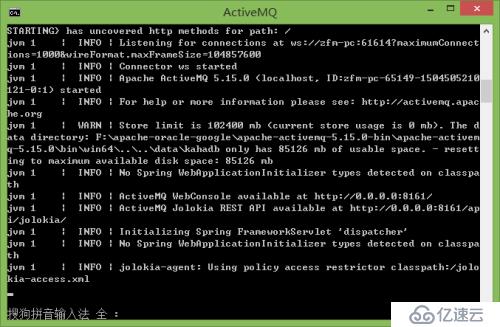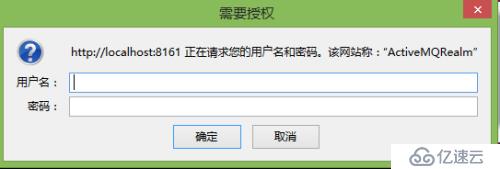1、下载ActiveMQ:http://activemq.apache.org/
2、解压包,并找到activemq.bat,双击打开一个控制台,跟你打开tomcat一样的。如图:

3、在浏览器查看你的activemq是否正确启动:http://localhost:8161/admin,打开之后看到这样:

用户名:admin 密码:admin
确定即可登录。
4、你可以新建一个Queue,在 Queue Name后面的方框中填入“MyFirstQueue”,点击正后方“Create”按钮即可。

在下面Queues:列表中,就会显示你刚刚新建的Queue:
 这是已经使用过的,其实一开始数值是这样的:
这是已经使用过的,其实一开始数值是这样的:
Name : MyFirstQueue
Number Of ending Message : 0
Number Of Consumers :0
Message Dequeued:0
5、接下来我们通过IDEA来创建两个java类,一个是消息生产者,一个是消息消费者。
这是消息生产者:
package com.zfm.activemq;
import org.apache.activemq.ActiveMQConnection;
import org.apache.activemq.ActiveMQConnectionFactory;
import javax.jms.*;
public class Sender {
private static final int SEND_NUMBER =5;
public static void main(String[] args){
//ConnectionFactory:连接工厂
ConnectionFactory connectionFactory;
//Connection:JMS客户端到JMS Provider的连接
Connection connection = null;
//Session :一个会话,发送或接收消息的线程
Session session;
//Destination:消息的目的地
Destination destination;
//MessageProducer:消息产生者:发送
MessageProducer messageProducer;
//构造connectionFactory实例对象
connectionFactory = new ActiveMQConnectionFactory(
ActiveMQConnection.DEFAULT_USER,
ActiveMQConnection.DEFAULT_PASSWORD,
"tcp://localhost:61616"/*ActiveMQ默认使用的TCP连接端口是61616,*/
);
try{
//构造从工厂得到的连接
connection = connectionFactory.createConnection();
//启动
connection.start();
//获取操作连接
session = connection.createSession(Boolean.TRUE,
Session.AUTO_ACKNOWLEDGE);
//获取session的参数
destination = session.createQueue("FMDemo");
//得到消息生成者
messageProducer = session.createProducer(destination);
//设置·不持久化
messageProducer.setDeliveryMode(DeliveryMode.NON_PERSISTENT);
//构造消息
sendMeaasge(session,messageProducer);
session.commit();
}catch (Exception e){
e.printStackTrace();
}finally {
try{
if(null!=connection){
connection.close();
}
}catch (Throwable t){
}
}
}
public static void sendMeaasge(Session session,MessageProducer producer) throws JMSException {
for(int i=1;i<=SEND_NUMBER;i++){
TextMessage message = session.createTextMessage("ActiveMq 发送的消息" +i);
//发送消息到目的地
System.out.println("发送消息: ActiveMq发送消息:" + i);
producer.send(message);
}
}
}消息消费者:
package com.zfm.activemq;
import org.apache.activemq.ActiveMQConnection;
import org.apache.activemq.ActiveMQConnectionFactory;
import javax.jms.*;
public class Receiver {
public static void main(String[] rags) throws JMSException {
//Connection连接工厂
ConnectionFactory connectionFactory;
//Connection:JMS客户端到JMS provider
Connection connection = null;
//Session : 一个发送或接受消息的·会话
Session session;
//Destination:消息的目的地,消息发送给谁
Destination destination;
//消费者,消息接收者
MessageConsumer messageConsumer;
connectionFactory = new ActiveMQConnectionFactory(
ActiveMQConnection.DEFAULT_USER,
ActiveMQConnection.DEFAULT_PASSWORD,
"tcp://localhost:61616"//ActiveMQ默认使用的TCP连接端口是61616,
);
try{
//从构造工厂里获得连接
connection = connectionFactory.createConnection();
//一定要启动
connection.start();
//从连接获得会话
session = connection.createSession(Boolean.FALSE
,Session.AUTO_ACKNOWLEDGE);
destination = session.createQueue("FMDemo");
messageConsumer = session.createConsumer(destination);
while(true){
//设置接收者接受新消息的时间
TextMessage message = (TextMessage)messageConsumer.receive(100000);
if(null!=message){
System.out.println("收到消息" + message.getText());
}else{
break;
}
}
}catch (Exception e){
}finally {
try{
if(null != connection) {
connection.close();
}
}catch(Throwable t){
}
}
}
}当运行Sender.java之后,刷新http://localhost:8161/admin/queues.jsp时,
Queues表中的参数有变化咯:
Name : MyFirstQueue
Number Of Pending Message :5
Number Of Consumers :0
Message Enqueued :5
Message Dequeued :0
此时,由于消息已经发完,并且我们没有让Sender的main函数一直运行,所以,在控制台打印了:
发送消息: ActiveMq发送消息:1
发送消息: ActiveMq发送消息:2
发送消息: ActiveMq发送消息:3
发送消息: ActiveMq发送消息:4
发送消息: ActiveMq发送消息:5
Process finished with exit code 0
进程结束了。
这时我们再运行Receiver.java,而后控制台打印:
收到消息ActiveMq 发送的消息1
收到消息ActiveMq 发送的消息2
收到消息ActiveMq 发送的消息3
收到消息ActiveMq 发送的消息4
收到消息ActiveMq 发送的消息5
Process finished with exit code 0
Name : MyFirstQueue
Number Of Pending Message :0
Number Of Consumers :0
Message Enqueued :5
Message Dequeued :5
还有一点是:当Receiver.java并没有运行结束的时候,由于我只开启了一个Receiver进程,所以这时Number Of Consumers:1。
可见,由Sender发出的消息已经被Receiver收到了。你可以先把Sender消息发出来,这个时候只要消息已经到消息队列上了,只要你不期望发送者还要接收什么回复,你就可以把Sender停掉了。Receiver还是一样的接收到信息。
下面介绍一下ActiveMQ的几种基本通信方式:发布-订阅模式和点对点模式。
基础流程:
1、获得ActiveMQConnectionFactory。
2、利用factory获得Connection。
3、启动connection。
4、通过connection创建Session。
5、指定Session的Destination。
6、发送消息者则创建MessageProducer/接收消息者创建MessageConsumer。
7、发送和接收JMS Message。
8、关闭所有JMS资源。
ActiveMQ详情见http://shmilyaw-hotmail-com.iteye.com/blog/1897635
讲到ActiveMQ,其实他是java消息服务(JMS)的其中一种规范,JMS详情见:http://blog.csdn.net/jiuqiyuliang/article/details/46701559 和 http://blog.csdn.net/jiuqiyuliang/article/details/47160259。
多个项目之间集成
(1) 跨平台
(2) 多语言
(3) 多项目
降低系统间模块的耦合度,解耦
(1) 软件扩展性
系统前后端隔离
(1) 前后端隔离,屏蔽高安全区
亿速云「云服务器」,即开即用、新一代英特尔至强铂金CPU、三副本存储NVMe SSD云盘,价格低至29元/月。点击查看>>
免责声明:本站发布的内容(图片、视频和文字)以原创、转载和分享为主,文章观点不代表本网站立场,如果涉及侵权请联系站长邮箱:is@yisu.com进行举报,并提供相关证据,一经查实,将立刻删除涉嫌侵权内容。